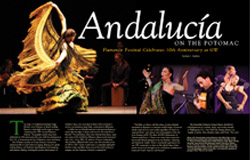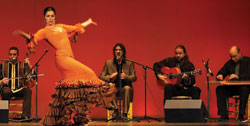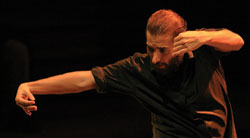Andalucia on the Potomac
Flamenco Festival Celebrates 10th Anniversary at GW
The magic of Andalucía envelops Foggy Bottom every February, as Spain’s leading flamenco artists light up the stage at Lisner Auditorium for GW’s annual Flamenco Festival. The popular month-long event celebrated its 10th anniversary this year with five performances Feb. 9 to 23 showcasing the best of flamenco music and dance.
One of Spain’s premier art forms, flamenco mesmerizes audiences with its sultry blend of singing, dancing, live guitar, twirling dresses, and rhythmic handclapping, foot stomping, and castanet clicking. Evoking the passion and romance of southern Spain, the centuries-old dance style continues to evolve, incorporating many fresh, contemporary influences.
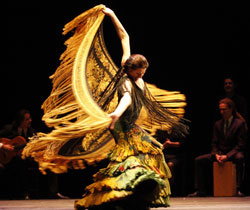
Internationally renowned flamenco artist Maria Pagés and her talented troupe presented their award-winning program Autoretrat, on Feb. 11.
Photo by Victoria Hidalgo
A stellar line-up of traditional and contemporary flamenco artists takes the stage at Lisner each year for the much-loved festival. “The performers, who come directly from Spain, represent some of the world’s best flamenco dancers and musicians,” says Carl J. Graci, BBA ’05, director of Lisner Auditorium, who has been affiliated with Lisner since the festival’s arrival at GW in 2000. “Lisner Auditorium is constantly looking for the best music and dance from around the world to bring to campus, and the Flamenco Festival is a natural fit.”
“The baile, or dance, and the cante, or song, interact seamlessly in flamenco to unleash soulful images of passion, which touch all of us universally regardless of where we originate from,” says dancer and choreographer Dana Tai Soon Burgess, MFA ’94, chair of GW’s Department of Theatre and Dance. “There is no other dance form that historically blends elements from the Muslim, Christian, and Sephardic worlds. What a wonderful opportunity for our GW community to share in this global dance form, which has moved throughout the world from Andalucía to Latin and South America and beyond.”
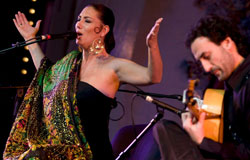
Flamenco singer Marina Heredia shared the stage with the Arab-Andalusian Chekara Orchestra of Tetouan on Feb. 21 for Tres Culturas.
Photo by Flemenco Festival USA
The brainchild of director Miguel Marin, the festival is headquartered in Cordoba, Spain, and travels annually to Washington, D.C., New York City, Miami, Boston, Los Angeles, London, Paris, Brussels, Japan, and China. The event has grown in size and scope over the years, expanding from two D.C. performances in 2000 to five today. Rounding out the festival are a number of community outreach events promoting Spanish culture. “This year, we offered complimentary Spanish ham and cheese tastings before two of the performances, courtesy of Jaleo Restaurant, as well as flamenco dance lessons on Lisner’s stage on Feb. 5,” Mr. Graci says. Flamenco Festival artists also presented a choreographed runway performance to live music at the Corcoran Gallery of Art on Feb. 8, showcasing historic costumes designed by Picasso and Dali.
The festival is eagerly anticipated each year by many local flamenco enthusiasts, such as Minerva Chandler, MBA ’09, who buys tickets to every one of the performances. A consultant at Booz Allen Hamilton, she fell in love with “everything flamenco” in the ’90s and is an active member of DC Flamenco, a group of aficionados in the Washington region. “I always buy extra tickets to all the events, as well, so that I can introduce others to flamenco the right way—with the world’s best flamenco artists,” she says. “It’s not just flamenco. It is the best flamenco you can get.”
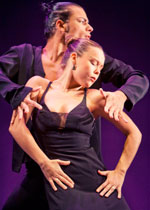
Flamenco artist Rocio Molina and her company took the stage at Lisner Feb. 14 for the Washington premiere of Oro Viejo, a new production exploring the passage of time.
Photo by Luis Castilla
This year’s festival kicked off Feb. 9 with the Gala Flamenca, followed by a Feb. 11 performance by the internationally acclaimed Compañia Maria Pagés. One of the leading innovators in modern flamenco, Pagés’ 15-member troupe presented Self Portrait, which won the Giraldillo Prize for Best Show at Seville’s 2008 Bienal de Flamenco. Next in the series was a Feb. 14 show featuring Compañia Rocio Molina. A star in the flamenco world, Rocio Molina led the talented troupe in the Washington premiere of Oro Viejo, exploring the passage of time.
Marina Heredia and the Arab-Andalusian Chekara Orchestra of Tetouan took the stage Feb. 21, followed by the final performance of the series on Feb. 23 featuring the celebrated Compañia Israel Galván. Hailed as both revolutionary and a traditionalist, Mr. Galván has won flamenco’s most prestigious awards, including Spain’s National Dance Prize. In his powerful show La Edad de Oro, the Golden Age, he was joined by renowned Spanish vocalist Fernando Terremoto.
“Each performance drew a wide audience from all over the D.C. metro area, including an excellent number of GW students,” says Mr. Graci, adding that many first-timers fall for flamenco the moment they see it. Ticket sales for the festival total 6,000 annually. “The Flamenco Festival has become increasingly popular over the years,” he says. “It is an annual highlight at Lisner, and we look forward to hosting it for many years to come.”
Flamenco Festival USA |
Flamenco Festival USA |

